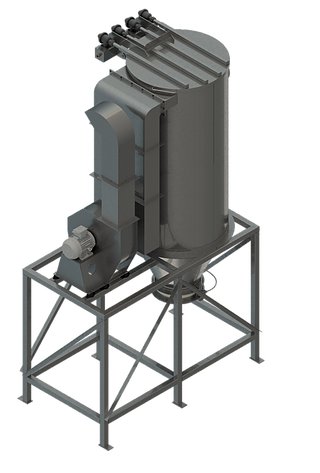What is a Dust Collector?
A dust collector is an industrial device designed to capture airborne particles, preventing them from polluting the air within a workspace. Dust collectors are critical for industries that handle fine materials, as they keep the air clean, maintain a safe work environment, and protect equipment from contamination.
The Importance of Dust Collection in Industrial Settings
Dust in the air isn’t just a nuisance—it can be a serious health hazard. In industrial settings like manufacturing, woodworking, and metalworking, dust can lead to respiratory issues, explosions, and reduced equipment efficiency. A quality dust collection system minimizes these risks, providing a safer environment for workers and a cleaner workspace.
How Dust Collectors Work
Dust collectors work by pulling in contaminated air, filtering out particles, and releasing clean air back into the environment. Let’s break down the process:
Overview of the Dust Collection Process
The system typically includes an intake fan that draws dust-laden air into the collector. Inside, filters or other mechanisms trap particles, which are then stored for disposal. The cleaned air is vented back into the room or outside the facility.
The Role of Air Filtration
Air filtration is key to any dust collection system. Filters, whether they are fabric, cartridge, or electrostatic, catch airborne particles, allowing only clean air to pass through.
Types of Dust Collectors
Different dust collectors are suited to various applications. Here’s a look at the main types:
Baghouse Dust Collectors
Popular in large-scale industrial settings, baghouse dust collectors use fabric filters or bags to trap dust particles. These systems are highly effective for handling large volumes of dust.
Cartridge Dust Collectors
Compact and efficient, cartridge dust collectors use pleated filters to capture dust. They’re ideal for facilities with limited space and moderate dust levels.
Cyclone Dust Collectors
Cyclone dust collectors use centrifugal force to separate dust from the air. They’re commonly used as a first stage in multi-stage dust collection systems, capturing larger particles.
Wet Scrubber Systems
Wet scrubbers use a liquid, usually water, to trap dust particles. They are effective in controlling dust from processes that produce fine, sticky, or combustible particles.
Electrostatic Precipitators
These systems use an electric charge to capture dust particles. They are particularly useful for capturing smoke and fine particles that would otherwise escape traditional filters.
Choosing the Right Dust Collector for Your Needs
Choosing the right dust collector depends on factors like dust type, volume, and the layout of the workspace. Considerations include filter type, airflow rate, and the dust collector’s efficiency in handling your specific contaminants. Sigrist Design specializes in helping industries find dust collection solutions tailored to their unique requirements, ensuring both safety and efficiency.

Key Components of a Dust Collection System
A typical dust collection system includes several essential components:
Ductwork
The ductwork directs dust-laden air from the workspace to the dust collector. Proper duct sizing ensures efficient airflow, reducing dust buildup.
Airflow Fans
Fans pull air through the ductwork and push it into the dust collector. The fan’s power must match the needs of the system to maintain optimal airflow.
Filters
Filters trap particles before clean air is released. Different systems use various filter types, including fabric, cartridge, and HEPA filters.
Understanding Air-to-Cloth Ratio in Dust Collectors
The air-to-cloth ratio measures the volume of air flowing through each square foot of filter media. A lower ratio improves filtration efficiency, making it a critical factor in dust collector performance.
Common Applications for Dust Collectors
Dust collectors are used in various industries, including:
- Woodworking: Capturing sawdust and wood particles
- Metalworking: Trapping metal shavings and fine dust
- Pharmaceuticals: Ensuring sterile environments by removing dust and contaminants
- Agriculture: Controlling dust in grain processing facilities
Advantages of Using Dust Collectors
Dust collectors provide numerous benefits:
- Healthier Air: Reduces airborne particles that pose health risks.
- Improved Equipment Life: Keeps machinery clean, reducing wear and tear.
- Regulatory Compliance: Helps businesses meet workplace air quality standards.
Environmental and Health Benefits
Reducing airborne particles not only creates a safer workspace but also minimizes pollutants released into the environment. This is vital in maintaining air quality standards and protecting workers’ health.
Maintenance Tips for Optimal Dust Collector Performance
Proper maintenance is essential for efficiency and longevity.
Regular Filter Replacement
Over time, filters become clogged, reducing airflow and performance. Regular replacement ensures consistent efficiency.
Cleaning and Inspection
Frequent cleaning of ducts and fan inspections help prevent dust buildup and ensure that the system operates smoothly.
Energy Efficiency in Dust Collection Systems
Modern dust collectors often include energy-saving features, such as variable speed fans. These adjustments lower energy use, saving costs while maintaining performance.

Dust Collector Safety Tips
To avoid accidents, ensure that all components are properly grounded to prevent static electricity buildup. Additionally, regular inspections and filter replacements are essential to maintain safety standards.
Cost of Installing and Maintaining a Dust Collector
The cost of a dust collection system depends on size, type, and features. Maintenance costs include filter replacements, energy expenses, and periodic cleaning services. Sigrist Design offers expert guidance on selecting dust collectors that meet specific budget and performance needs, making it easier to balance cost with effectiveness.
Conclusion: Investing in a Dust Collector for a Cleaner, Healthier Workplace
A dust collector is more than a piece of equipment; it’s an investment in health, safety, and compliance. By capturing harmful particles, dust collectors protect workers, reduce environmental impact, and extend the life of industrial equipment. For any industry that generates dust, installing a dust collection system is a step towards a cleaner, healthier workplace.